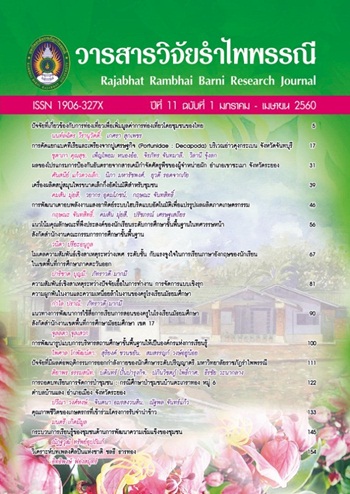การคัดแยกแบคทีเรียและเพรียงจากปูเศรษฐกิจ (Portunidae : Decapoda) บริเวณอ่าวคุงกระเบน จังหวัดจันทบุรี
Main Article Content
บทคัดย่อ
การคัดแยกเชื้อแบคทีเรีย และเพรียงจากปูเศรษฐกิจ (Portunidae: Decapoda) จำนวน 3 ชนิด ได้แก่ ปูม้า ปูดำ และปูลาย จากบริเวณอ่าวคุ้งกระเบน จังหวัดจันทบุรี ตั้งแต่เดือนมกราคม ถึงธันวาคม 2558 โดยใช้เครื่องมือประมงลอบและอวนจมปูม้าในบริเวณอ่าวคุ้งกระเบน จากนั้นทำการตรวจสอบเชื้อแบคทีเรียที่คัดแยกได้จากอวัยวะส่วนต่าง ๆ ของปูเศรษฐกิจ 5 บริเวณ ได้แก่ กล้ามเนื้อ เหงือก หัวใจ ตับ และกระเพาะอาหาร ศึกษาสัณฐานวิทยาของเชื้อภายใต้กล้องจุลทรรศน์และการทดสอบปฏิกิริยาทางชีวเคมีเบื้องต้น และการศึกษาชนิด ตำแหน่งที่มีการเข้าอยู่อาศัยของเพรียง รวมไปถึงปัจจัยที่มีผลต่อการเข้าอยู่อาศัยของเพรียงบนตัวปูแต่ละชนิด เช่น เพศ ขนาด และฤดูกาล ผลการศึกษาพบเชื้อแบคทีเรียในปูม้า (Portunus pelagicus) 5 สกุล จากเชื้อที่คัดแยกได้ 11 ไอโซเลต โดยพบในบริเวณเหงือกมากที่สุด ส่วนปูดำ (Scylla transquebarica) พบ 3 สกุล จากเชื้อที่คัดแยกได้ 10 ไอโซเลต และปูลาย (Charybdis feriatus) พบ 6 สกุล จากเชื้อที่คัดแยกได้ 9 ไอโซเลต โดยพบเชื้อแบคทีเรียชนิด Vibrio sp. มากที่สุดในปูทุกชนิด สำหรับชนิดของเพรียงที่เข้าอยู่อาศัยในปูทุกชนิด พบว่าเป็นเพรียงถั่วงอกสกุล Octolasmis sp. โดยพบในบริเวณเหงือกมากที่สุด ส่วนเพรียงหิน Chelonibia sp. พบในปูม้าและปูดำเท่านั้น โดยพบในบริเวณขาเดิน และกระดอง การทดสอบปัจจัยที่มีผลต่อการเข้าอยู่อาศัยของเพรียงของปูม้าและปูดำ พบว่าปัจจัยเรื่องเพศ ขนาด และฤดูกาลไม่มีความแตกต่างอย่างมีนัยสำคัญ (P>0.05) ในขณะที่ฤดูกาลมีผลต่อการเข้าอยู่อาศัยของเพรียงในปูลาย (P<0.05) โดยช่วงฤดูแล้ง เพรียงจะมีการเข้าอยู่อาศัยในปูลายมากกว่าในฤดูฝน (P<0.05)
Article Details
เอกสารอ้างอิง
2. ชุติมากรณ์ ชำนาญชล, เปรมใจ คำจันทร์ และวาสนา เพชรเรือง. 2557. ระบบการทำประมงปูม้าเพื่อการจัดการที่ยั่งยืน บริเวณอ่าวคุ้งกระเบน จังหวัดจันทบุรี. ครุศาสตรบัณฑิต สาขาวิทยาศาสตร์ คณะครุศาสตร์ มหาวิทยาลัยราชภัฏรำไพพรรณี.
3. บรรจง เทียนส่งรัศมี และบุญรัตน์ ประทุมชาติ. 2542. สถานการณ์ทรัพยากรปูทะเลของไทยในปัจจุบัน. ในการประชุมวิชาการของมหาวิทยาลัยเกษตรศาสตร์ ครั้งที่ 37 กรุงเทพฯ: มหาวิทยาลัยเกษตรศาสตร์.
4. เพ็ญโพยม หนองอ้อ. 2556. การคัดแยกแบคทีเรีย และเพรียงจากปูม้า บริเวณอ่าวคุ้งกระเบน จังหวัดจันทบุรี. ปริญญาวิทยาศาสตรบัณฑิต เอกชีววิทยาประยุกต์ คณะวิทยาศาสตร์และเทคโนโลยี มหาวิทยาลัยราชภัฏรำไพพรรณี จันทบุรี.
5. สมาคมอาหารแช่เยือกแข็งไทย. 2557. ผลผลิตปูม้าที่มีการส่งออกตั้งแต่ปี 2543-2554. http://www.thai-frozen.or.th/csr_tffa_04.php เข้าถึงเมื่อ 15 กุมภาพันธ์ 2557.
6. Alsaqabi, S. M. ; Eshky, A. A. ; Albelali, A. S. 2010. Parasitic Infections in The blue crab swimmer Portunus pelagicus (Linneaus, 1758), (Arthropoda: Crustacea) found in the Arabian Gulf, Kingdom of Saudi Arabia. Arab Gulf Journal of Scientific Research, 28: 185-196.
7. Davis, J.W. and Sizenmore, R.K. 1982. Incidence of Vibrio species associated with blue crab (Callinectes sapidus) collected from Galveston Bay, Texas. Applied Environmental Microbiology, 43: 1092-1097.
8. Enany, M.E., Abou El-Atta, M.E. and El. Tantawy, M.M. 2012. Incidence of some bacterial pathogens in summer season from shell diseased crab in the Suez Canal region. Egyptian Journal for Aquaculture, 2(2): 51-61.
9. Food and Agriculture Organization of the United Nation. 2013. Access. http://www.fao.org/home/en/. 15th February 2014.
10. Gaddes, S.W. and Sumpton, W.D. 2004. Distribution of barnacle epizoites of the crab Portunus pelagicus in the Moreton Bay region, eastern Australia. Marine and Freshwater Research, 55: 241-248.
11. Harvell, C.D., Kim, K., Burkholder, J.M., Colwell, R.R., Epstein, P.R., Grimes, D.J., Hofmann, E.E., Lipp, E.K., Osterhaus, A.D.M.E., Overstreet, R.M., Porter, J.W., Smith, G.W. and Vasta, G.R. 1999. Emerging marine Diseases-climate links and anthropogenic factors. Sciences, 285: 1505-1510.
12. Holt, J.G., Kreig, N.R., Sneath, P.H.A., Staley, J.T. and Williams, S.T. 1994. Bergey’s manual of determinative bacteriology. Maryland: Lippincott Williams & Wilkins.
13. Jeffries, W.B., Voris, H.K. and Yang, C.M. 1982. Diversity and distribution of the pedunculate barnacle Octolasmis in the seas adjacent to Singapore. Journal of Crustacean Biology, 2: 562-569.
14. Jithendran, K.P., Poornima, M., Balasubramanian, C.P. and Kulasekarapandian, S. 2010. Diseases of mud crabs (Scylla spp.): an overview. Indian Journal of Fish, 57(3):55-63.
15. Kannathasan, A. and Rajendran, K. 2010. Isolation of microbes from various tissues of marine crab Charybdis natator (Herbst, 1789) (Brachyura: Portunidae). International Journal of Recent Scientific Research, 7: 172-176.
16. Key, M.M., Volpe, J.W. Jr., Jeffries, W. and Voris, H.K. 1997. Barnacle fouling of the blue crab Callinectes sapidus at Beaufort, Northern Carolina. Journal of Crustacean Biology, 17: 424-439.
17. Lerssutthichawal, T. and Penprapai, N. 2013. Seasonal distribution and host-parasite interaction of pedunculate barnacle, Octolasmis spp. on orange mud crab, Scylla olivacea. Walailak Journal of Science and Technology, 10(2): 113-119.
18. Meyers, T.R., Koeneman, T. M., Botelho, C., and Short, S. 1987. Bitter crab disease: a fatal dinoflagellate infection and marketing problem for Alaskan Tanner crabs Chionoecetes bairdi. Disease Aquatic Organism, 3: 195-216.
19. Mushtaq, S. and Mustaquim, J. 2009. The occurrence and distribution of stalked barnacles of the genus Octolasmis on the gill of mud or mangrove crab, genus Scylla. Crustaceana, 82(1): 53-61.
20. Rajendran, K., Kavitha, P., and Anbalagan, T. 2008. Isolation of fungi and bacteria from variation tissues of ice store marine crab Charybdis feriata (Decapoda :Portunidae). Journal of Aquatic Biology, 23(1): 181-184
21. Shields, J.D. 1992. Parasites and symbions of the crab Portunus pelagicus from Mortan Bay, eastern Australia. Journal of Crustacean Biology, 12(1): 94-100.
22. Sizemore, R. K., Colwel, R. R., Thbiash l, H. S. and Lovelace, T. E. 1975. Bacterial flora of the hemolymph of the blue crab, Callinectes sapidus: most probable numbers, Applied Microbiology, 29: 393-399.
23. Talpur, A.D., Memon, A.J., Khan, M.I., Ikhwanuddin, M., Danish Daniel, M.M. and Abol-Munafi, A.B. 2011. A novel of gut pathogenic bacteria of blue swimming crab Portunus pelagicus (Linnaeus, 1758) and pathogenicity of Vibrio harveyi a transmission agent in larval culture under hatchery conditions. Research Journal of Applied Sciences, 6(2); 116-127.


